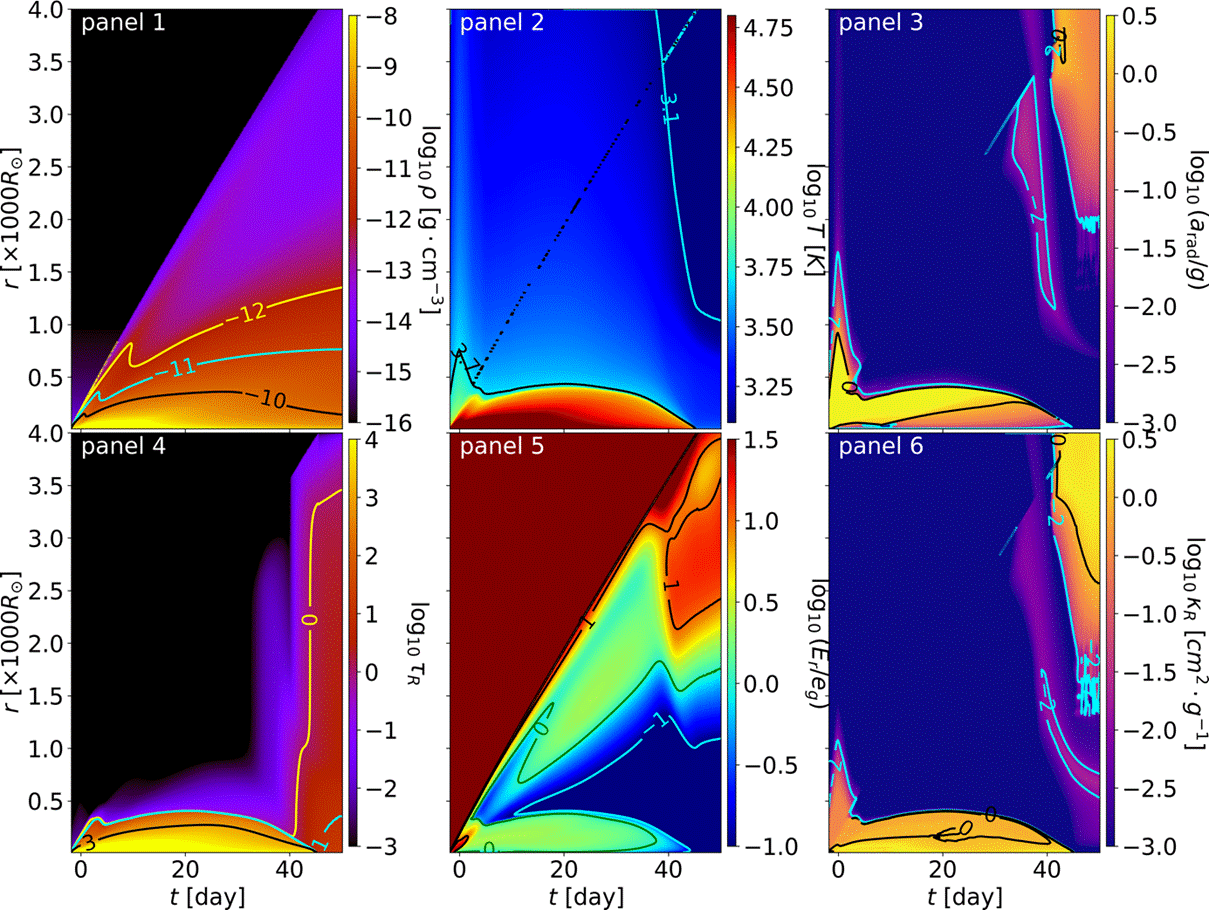Luminous red novae (LRNe) and common envelope evolution (CEE) are closely related astrophysical phenomena and evolutionary processes that are not well understood. Among them, CEE is a crucial stage in binary stellar evolution. Close compact binaries, Type Ia supernovae, hot sub-dwarfs, and gravitational wave sources may all be the product of CEE. On the other hand, LRNe are bright transients with peaks and plateaus in optical and near infrared bands which may be associated with CEE and binary interactions. Chen Zhuo, an associate research professor at the Tsinghua University Institute for Advanced Study (formerly a postdoc at the DoA), has studied the connection between CEE and LRNe, revealing the underlying physical processes through first-principle radiation-hydrodynamic simulations.
Due to the thick envelopes, it is difficult to understand how binary stars inside their common envelope evolve through direct observational means. However, LRNe, as a phenomena potentially associated CEE, provide us with valuable windows for studying CEE. Unfortunately, existing observations of LRNe often lack information about their progenitor stars because the progenitor stars of LRNe may not be very bright. This makes it challenging for us to understand the connection between CEE and LRNe .

Figure . For reach panel the x and y axis are the evolutionary time and radii, respectively, with t=0 adjusted to the peak of the luminosity. From Panel 1 to Panel 6, they are the density, temperature, ratio of radiation force and gravity, optical depth, ratio of radiation energy and gas internal energy, and Rosseland mean opacity.
However, through first-principle radiative hydrodynamical modeling, we can establish a preliminary connection between LRNe and CEE. With a one-dimensional hydrodynamic model and an equation of state (EoS) that accounts for radiative forces and hydrogen-helium ionization/dissociation, we revealed the causes of the peaks and plateaus of LRNe. Using the event AT 2019zhd as an example, through observational and dimensional analysis we estimated its central mass to be approximately 6 solar masses. Based on this estimation, we fitted the light curve of AT 2019zhd and speculated that the mass of the ejecta is between 0.04-0.1 solar masses. Furthermore, by comparing the simulation results of the complete physical model with those where radiative forces, hydrogen-helium EoS, and the effects of dust formation are artificially removed, we demonstrated that radiative forces and a realistic EoS decisively influence the light curve, while the effect of dust formation is limited. This is because the radiative force acting on the ejecta of LRNe dominates gravitational forces during the early stages when the ejecta are hot (panel 2), fully ionized (panel 3), and therefore opaque (panel 6). Subsequently, the recombination energy stored in hydrogen and helium extends the cooling time of the ejecta, explaining the plateau phase of the light curve of LRNe. It was found that late formation of dust has only minimal kinetic effects on the ejecta. The new model not only enable us to predict the observables of LRNe, but will also allow us to deduce the properties of the progenitor stars from LRNe by fitting their observables. Our next step includes combining the first-principle model with deep learning techniques to give us a better relation between CEE and LRNe at lower computational expense. This prepares us theoretically for the advent of the era of time-domain astronomy opened by CSST, MUST, LSST and WFIRST.
This work has been published in "The Astrophysical Journal Letters." The first and corresponding author is Chen Zhuo from the Tsinghua University Institute for Advanced Study and Department of Astronomy. This work was supported by the National Natural Science Foundation of China, the Tsinghua University Dushi Program, and the Shuimu Tsinghua Scholar Program.
Link to the paper: https://iopscience.iop.org/article/10.3847/2041-8213/ad2a47
References
Pastorello, A., Fraser, M., Valerin, G., et al. 2021, A&A, 646, A119
Cai, Y., Reguitti, A., Valerin, G., & Wang, X. 2022, Univ, 8, 493
Matsumoto, T., & Metzger, B. D. 2022, ApJ, 938, 5


